Are you planning to adopt a German Shepherd puppy for the first time and want to raise it at home, but no idea whatsoever how to take care, train, and raise? Don’t worry! you’re in the right place.
In this article, we will guide you on how a first-time German Shepherd puppy owner can take care and train a German Shepherd puppy at home, so that it will be raised as a healthy, obedient, social, and lovely family dog.
Quick Overview
Before you go through the main content, here is a quick overview of what a new German Shepherd puppy owner is expected to do:
- Bringing a German Shepherd puppy into your home for the first time is an exciting experience filled with joy and responsibilities. As a new owner, it’s crucial to prepare your home in advance, ensuring it is safe and puppy-proofed. Start with setting up a comfortable, dedicated space where your puppy can rest and feel secure.
- Investing in high-quality puppy food specifically formulated for German Shepherd breeds is vital for its growth and health.
- Complete the series of puppy vaccinations by visiting the vet, and take care of puppy’s grooming routine.
- Early socialization is key; introduce your puppy to various people, sights, and sounds to help it become well-adjusted adult.
- Establishing a routine early on is essential, including regular feeding times, potty breaks, and exercise.
- German Shepherds are highly intelligent and energetic, requiring ample physical exercise and mental stimulation to prevent boredom and destructive behavior.
- Training should begin immediately, focusing on basic commands like sit, stay, and come, which are critical for its safety and your control.
- Positive reinforcement techniques, such as treats and praise are very effective because they help you to strengthen the bond between you and puppy.
Have You Bought a Puppy?
If you haven’t already bought a German Shepherd puppy, read these important articles that will help you to buy a pure and desired German Shepherd puppy.
- Monthly & Annual Expenses of Owning a German Shepherd
- How to Know German Shepherd Puppy is Male or Female | Gender
- How to Determine the Age of German Shepherd Puppy or Dog
- Slant Back German Shepherds | Types of Showline GSDs
- Straight Back German Shepherds | Types of Working Line GSDs
- How to Spot a Fake German Shepherd Puppy | 10 Tips
- How to Identify the Purity of German Shepherd Puppy | 5 Ways
- Is There a Mini German Shepherd Breed Exist?
- Male or Female German Shepherd: Which One is Better?
- Do German Shepherd Puppies Lose Their Teeth?
Main Topics
The following topics will be covered in this article:
- Overview of Taking Care of German Shepherd Puppies In Different Stages
- Puppy-Proofing Your Home
- How to Prepare Rest and Sleep Space for German Shepherd Puppies at Home
- Diet Plan for German Shepherd Puppies in Different Stages
- How to Potty Train a German Shepherd Puppy
- How to Train a German Shepherd Puppy in Different Stages
- Toys for German Shepherd Puppies
- German Shepherd Puppy Grooming
01. Overview of Taking Care of German Shepherd Puppy in Different Stages
Taking Care of a German Shepherd puppy involves a series of continuous steps, each tailored to its developmental stages, ensuring it grows into a well-adjusted, healthy adult dog.
Initially, at 8 weeks old, when most puppies are ready to leave their mother, the first concern is nutrition; a high-quality puppy food (Read Section 4) designed for large breeds is essential. Feeding should be on a strict schedule, three to four times a day, to support its rapid growth without overburdening its digestive system. Around this time, setting up a comfortable sleeping area (Read Section 3) helps with its transition, making it feel secure in its new environment. As German Shepherd puppies are highly energetic, providing ample playtime and exercise is critical, but remember, their bones and joints are still developing, so activity should not be too strenuous.
At about 12 weeks, socialization becomes key; exposing it to various people, animals, and environments will help in developing a well-rounded temperament. This is also the prime time to begin basic obedience (Read Section 6) training, as German Shepherds are eager learners. Positive reinforcement techniques work best, fostering a strong bond between the puppy and the owner. Vaccinations and deworming are crucial at this stage to protect the puppy from common canine diseases and parasites. Regular vet check-ups should be scheduled to monitor its growth and overall health.
To know more about puppy vaccinations, schedule, diseases (Distemper, parvovirus, parainfluenza, DHPP, rabies), and how much vaccinations cost, read this: First Year Puppy Vaccination Schedule Recommended By AKC.

By 6 months, teething becomes an issue; providing appropriate chew toys will help alleviate its discomfort. Exercise needs increase as it grows, so integrating more physical activities and mental stimulation is necessary to keep it engaged. This age also marks the beginning of adolescence, where consistent training and socialization are crucial to manage its increasing independence and strength.
As it approaches 1 year, transitioning to adult dog food should be gradual to avoid digestive issues. This stage also often requires adjustments in its exercise regimen to match its adult energy levels, promoting physical health and mental well-being. Spaying or Neutering is recommended around this time, depending on your vet’s advice, which can help prevent health and behavioral issues.

Throughout these stages, continuous training, regular health checks, and lots of love and patience are essential. Properly caring for a German Shepherd puppy is rewarding that lays the groundwork for a loyal, protective, and loving companion for years to come.
Related: German Shepherd Energy Levels by Age | Activity Needs
02. How to Puppy-Proofing Your Home
Puppy-proofing your home is an essential step to undertake before welcoming a new puppy into your life. It not only ensures the safety of the puppy but also protects your belongings from its curious behavior.
Start by securing all electrical cords and outlets, as puppies often chew on anything they can find.
Keep all small objects and choking hazards, such as coins, rubber bands, and small toys, out of reach.
It’s crucial to safeguard your plants as well since some common household plants can be toxic to dogs if ingested.
Installing baby gates can restrict access to certain areas of your home, preventing your puppy from wandering into potentially dangerous places.

Cabinets, especially those containing cleaning supplies and medications, should be securely fastened with child-proof locks.
Rugs and loose carpets may need to be temporarily removed or secured to the floor to prevent slips or chewing.
Ensure that trash cans are covered or stored in a locked cabinet, as puppies can easily be tempted by the smell and accidentally ingest something harmful.
Shoes, laundry, and other personal items should be kept off the floor and out of reach since puppies are known for their love of chewing.
Providing plenty of safe, chewable toys can help satisfy its teething needs and keep it entertained.
It’s also wise to check your yard for any escape routes or hazardous materials, ensuring a safe outdoor environment for your puppy.
Training your puppy on what is off-limits from the start plays a crucial role in puppy-proofing effectively. Regularly monitor your puppy and adjust puppy-proofing measures as it grows is necessary, because its capabilities and interests will change gradually.
03. How to Prepare Rest and Sleep Space for German Shepherd Puppy at Home
Preparing a rest and sleep space for a German Shepherd puppy requires careful consideration to ensure that it feels safe, comfortable, and secure.
First, choose a quiet area in your home where the puppy can rest undisturbed, away from high-traffic zones. It’s important to select a spot that is temperature-controlled, neither too hot nor too cold, that will keep your puppy comfortable in all seasons.
The sleeping area should include a durable, puppy-sized bed with a washable cover to maintain hygiene and provide soft support for your puppy’s growing body. You can also add a blanket for extra warmth and comfort. Elevating the bed slightly off the ground can help protect your puppy from drafts, while ensuring the bed has a low entry point so the puppy can easily climb in and out.

Installing a puppy gate can restrict the puppy’s movement at night, ensuring it stays in its designated sleep area. Providing chew toys in the bed can help soothe your puppy and keep it entertained if it wakes up during the night.
Avoid placing the bed in direct sunlight or too close to heating elements to prevent overheating. Consider using a white noise machine or soft music to drown out any external sounds that might disturb your puppy’s rest.
Remember to gradually acclimate your puppy to spend time in its bed during the day, with supervised nap times, so it becomes a familiar and secure place. Regularly cleaning the bed and the sleep area will prevent the build-up of odors and maintain a pleasant sleeping environment.
By following these measures, a puppy owner can create a restful and sleep-friendly space at home that meets the needs of his growing German Shepherd puppy.
04. Diet Plan for German Shepherd Puppies in Different Stages
Raising a German Shepherd puppy requires a careful attention of owner to its diet at every stage of its early life to ensure it grows into a strong, healthy adult.
From the time a puppy is weaned off its mother’s milk at about 8 weeks, these puppies need a diet rich in proteins, fats, carbohydrates, vitamins, and minerals. It’s advisable to start with commercially prepared high-quality puppy food specifically formulated for large breeds, ensuring it meets the AAFCO guidelines for growth. Brands like Royal Canin and Hills Science Diet offer specialized formulations that cater to the needs of German Shepherd puppies, balancing nutrients essential for bone development and overall growth.

At around 3 to 6 months, a German Shepherd puppy’s diet should still be primarily composed of puppy kibble, but you can start incorporating small amounts of home-cooked foods. Lean meats such as chicken, turkey, and beef, cooked thoroughly and deboned, can be a good protein source. Vegetables like carrots and green beans, lightly steamed to preserve its nutrients, can be introduced in small quantities as well. However, it’s critical to avoid foods that are toxic to dogs, such as onions, garlic, and grapes.
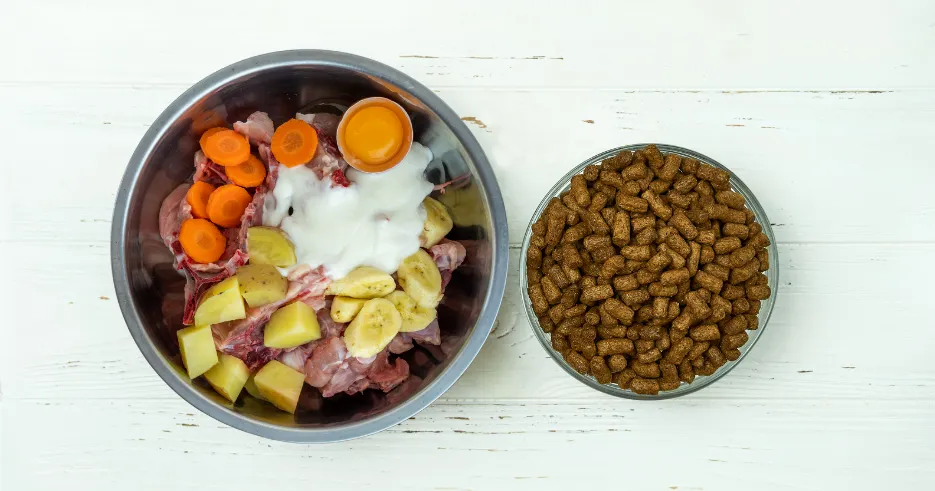
Moving into the 6 to 12-month stage, the puppy’s growth rate starts to slow down. This is the time to gradually transition it to an adult food formula, to prevent rapid weight gain which can lead to skeletal problems. The transition should be gradual over a week or longer, mixing the new food with the puppy food in slowly increasing proportions. Feeding portions and frequency might also change; follow the guidelines provided by the food manufacturer or consult with a vet.
Home-prepared diets can be more prominent during this stage, comprising cooked lean meats, rice, and vegetables. Ensure the homemade portion does not exceed 10% of the total diet to keep the nutrient balance intact. Supplements can be necessary when feeding home-cooked meals, especially to support joint health, given the breed’s susceptibility to hip dysplasia. Fish oil and glucosamine supplements, recommended by a vet, can be beneficial.

By the time your German Shepherd reaches 12 months, it should be fully transitioned to an adult dog food, maintaining a balance of protein, fats, and carbohydrates suited to its size and energy level. High-quality brands like Orijen and Blue Buffalo provide options for adult German Shepherds, focusing on meat-based proteins and providing grain-free options for dogs with sensitivities. Continuing with a mix of branded dog food and balanced vet-approved homemade meals will make it a strong and healthy adult dog.
Throughout these stages, hydration is paramount. Ensure fresh water is always available. Regular vet check-ups will help tailor the diet plan to your German Shepherd puppy’s specific needs.
05. How to Potty Train a German Shepherd Puppy
Potty training a German Shepherd puppy requires patience, consistency, and understanding of its capabilities and needs. Start by establishing a regular feeding schedule, as this will also help regulate its elimination schedule.
Take your puppy outside to the same spot each time it needs to go, ideally every two hours, and immediately after it wakes up, during and after playing, and after eating or drinking.
Use a specific word or phrase like “go potty” each time to help it associate the command with the action. Praise and treat your puppy immediately after it goes potty in the correct spot to reinforce the behavior positively.

If your puppy does poo/pee inside home, don’t punish it. Instead, if you catch puppy in the act, calmly take it outside to finish, then praise it. Clean any indoor poo/pee thoroughly with an enzymatic cleaner to remove odors that might attract it back to the spot.
Crate training can be an effective potty training tool, as dogs naturally avoid soiling their sleeping area. However, ensure the crate is the right size, not too big that your puppy has a corner to relieve itself in, but not so small that it is uncomfortable.

Supervise your puppy as much as possible and look out for signs that it needs to go, like sniffing, circling, or whining. Establishing a routine and sticking to it is key, as it helps your puppy learn what’s expected. If potty training isn’t progressing, consider consulting with a professional trainer or veterinarian to ensure there aren’t any underlying issues.
RELATED: Effective Methods for Crate Training German Shepherd Puppy
06. How to Train a German Shepherd Puppy in Different Stages
Always keep in mind that training a German Shepherd puppy involves patience, consistency, and understanding of the breed’s specific needs through different stages of its development.
Initially, focus on socialization; expose your puppy to various environments, people, and other animals to build confidence and prevent future aggression or fear. Start with basic commands such as “sit,” “stay,” “come,” and “down” using positive reinforcement techniques, rewarding desired behaviors to encourage repetition.

Training sessions should be short but frequent, maintaining the puppy’s attention span. Crate training, as mentioned above, is beneficial for housebreaking, as it taps into the dog’s natural denning instinct, providing a safe space and helping establish a routine. As your puppy grows, gradually increase the complexity of commands and introduce leash training.
Related: Training German Shepherds for Families With Young Children
Incorporate agility training to keep it physically and mentally stimulated. By the time your puppy reaches adolescence, typically around six months, reinforce training with more challenging tasks and consistency in commands to deal with any emerging stubbornness or independence.
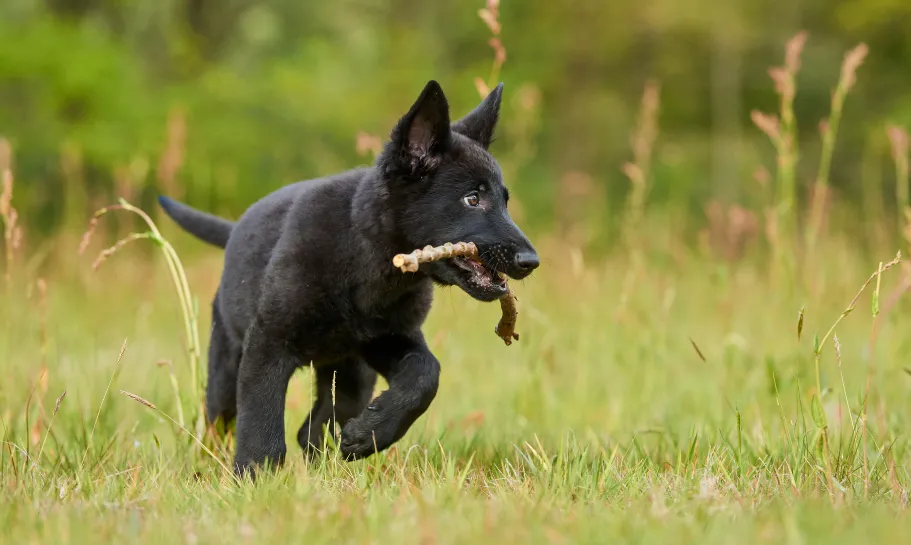
In addition to obedience, work on behavior shaping, correcting unwanted behaviors like jumping or excessive barking early on. Regular, varied training sessions prevent boredom and encourage learning.
As your German Shepherd puppy matures, you can introduce specialized training based on its strengths, such as search and rescue, protection, or therapy dog training, etc.

07. Toys for German Shepherd Puppies
German Shepherd puppies, known for their intelligence and high energy levels, require toys that cater to their natural instincts and developmental needs.
A common favorite is the classic rubber Kong toy.
The Rope toys are also excellent for German Shepherds, as they can withstand the vigorous tugging and help in cleaning their teeth while they play.
Squeaky toys ignite their curiosity and keep them engaged, but always ensure they are made of durable materials to withstand their strong jaws.
Interactive puzzle toys are crucial for this intelligent breed, challenging their minds and preventing boredom.

Frisbees offer another avenue for exercise, perfect for outdoor play and training their agility and catch.
Chew toys, particularly those that are flavored or have a texture, are indispensable for teething puppies, providing relief and keeping them from chewing on inappropriate items.
Plush toys can offer comfort, especially for younger puppies, but it’s important to choose ones specifically designed for dogs to ensure they don’t pose a choking hazard.
Tug toys made of tough materials satisfy their need for interactive play and can also be used as training tools.

Floating toys enhance playtime in water, catering to this breed’s love for swimming.
Treat-dispensing toys reward them for their problem-solving skills, making treat time fun and stimulating.
Toys that mimic the movement of prey, such as automated moving toys, engage their natural hunting instincts.
Related: German Shepherd Teeth Problems: Causes, Prevention, Treatment
A good variety of toys not only keeps them physically active but also supports their cognitive development. Always rotate its toys to keep its interest peaked and prevent boredom. It’s crucial to supervise your German Shepherd puppy during playtime to ensure it doesn’t ingest any parts of the toys. Regularly inspect its toys for signs of wear and tear, replacing them as necessary to avoid potential hazards.
Training toys, such as dummies or scent items, can also be introduced to prepare it for more advanced tasks and obedience training.

Durable materials like hard rubber, nylon, or strong fabric are preferable for longevity.
Lastly, socialization toys, like those used in interactive play with other dogs, help in their behavioral development, teaching the necessary skills to interact with other dogs and people.
08. German Shepherd Puppy Grooming
Grooming of a German Shepherd puppy is an essential aspect of its overall care routine, which not only keeps it looking its best but also supports its health and wellbeing. German Shepherd puppies should be introduced to a grooming routine early on, ideally starting when they are about 8 weeks old, to help them become accustomed to being handled and brushed.
Bathing a German Shepherd Puppy
Generally, it is advisable to bathe a German Shepherd puppy no more than once a month unless it get particularly dirty or smelly. Overbathing can strip their coat of essential oils, leading to dry, irritated skin.
Before bathing your puppy, it’s important to gather all necessary supplies, including a dog-specific shampoo, a towel, and a brush. Water temperature is key; ensure it is warmly tepid, not too hot or too cold, to keep your puppy comfortable.
Some of the best shampoo brands for German Shepherd puppies include Earthbath, Burt’s Bees, and Veterinary Formula.
How to Give a Bath to a German Shepherd Puppy?
The right way to give a bath to a German Shepherd puppy involves the following steps:
- Gently introduce your German Shepherd puppy to the water, wet its coat thoroughly but carefully to avoid getting water in its ears, which can cause infections.
- Apply a small amount of puppy-formulated shampoo to its coat. Lather gently, avoiding its eyes and ears from the inside, as these areas are sensitive. It’s beneficial to talk to your puppy in a calm and reassuring tone throughout the bath to help it stay relaxed.
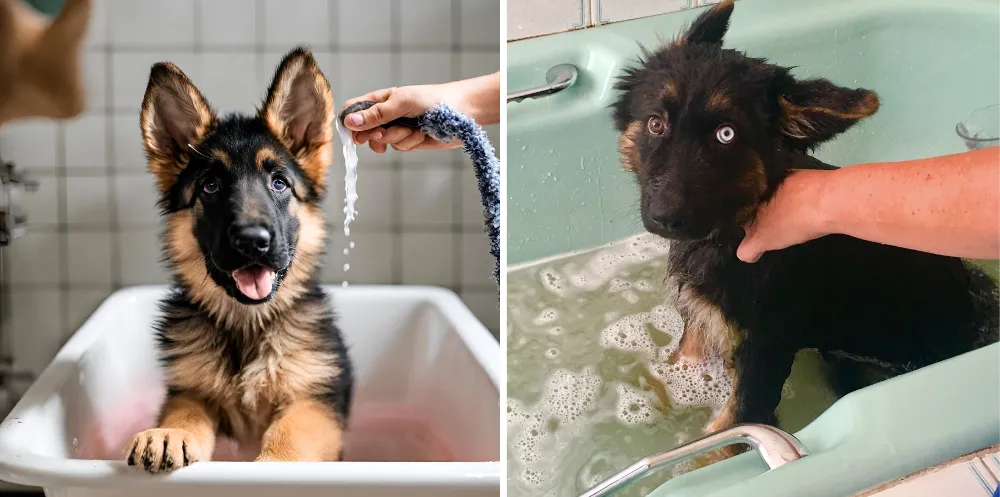
- After thoroughly rinsing the shampoo from its coat, ensuring no residue is left, gently wrap it in a towel and dab the water off. Avoid rubbing vigorously, as this can tangle its fur.
- After the bath, it’s a good idea to brush your German Shepherd puppy once it is somewhat dry, to prevent mats and tangles in its fur. If your puppy seems unsettled by the blow dryer, let it air dry in a warm, draft-free area instead. In colder months, make sure your puppy is completely dry before allowing it to go outside.
- Always praise your puppy and possibly offer a small treat after the bath to help it associate bathing with positive experiences.
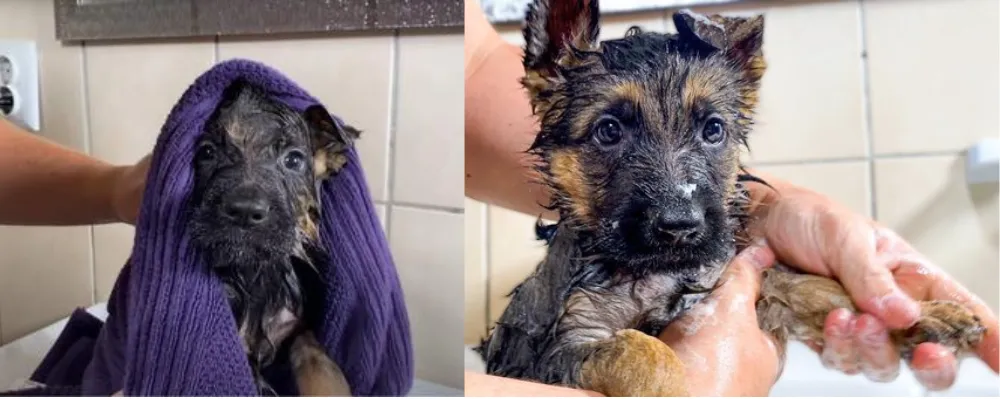
RELATED
How to Give German Shepherd a Bath: A Complete Guide
Brushing a German Shepherd Puppy
Ideally, a German Shepherd puppy should be brushed at least once every two to three days. This frequency helps in managing its dense and often double-layered coat, and significantly reduces shedding around the home.
Regular brushing from a young age acclimatizes it to the process, making it more comfortable and easier to manage as it grows. It also helps in distributing natural oils throughout its coat, keeping it shiny and healthy.
How To Brush a German Shepherd Puppy?
The right way to brush/comb a German Shepherd puppy involves the following steps:
- Gently introduce the brush to your puppy, letting it sniff and inspect it to build trust. Start brushing at the head, moving in the direction of hair growth, and work your way down the body to the tail, ensuring you’re gentle around sensitive areas.
- Use the slicker brush to gently work through any tangles or mats, being extra careful not to pull on their skin.
- Follow up with a bristle brush, which helps distribute natural oils through its coat, promoting a healthy shine. Make sure to also brush its legs and belly, areas that can often be overlooked but are just as important.
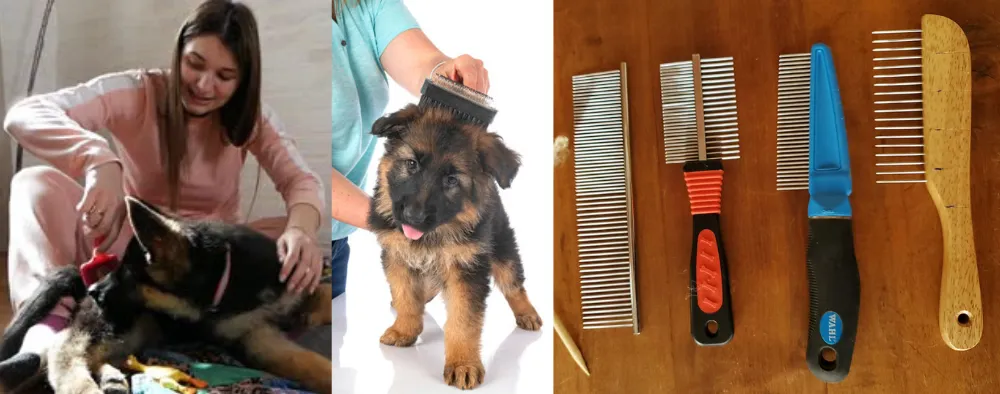
During shedding season, which occurs twice a year, you may need to increase the brushing frequency to daily in order to manage the increased hair loss. Utilizing the right tools, such as a slicker brush for the topcoat and a de-shedding tool for the undercoat, will make the process more efficient and comfortable for the puppy.
Other Grooming Tasks
It’s also important to pay attention to other grooming tasks, such as trimming nails regularly (Watch: How To Trim Dog Nails Safely), checking and cleaning ears (Watch: How To Clean German Shepherd Ears), and brushing teeth (Watch: How to Brush German Shepherd Teeth At Home). These aspects of grooming are crucial for preventing infections, dental diseases, and discomfort.
Final Thoughts
For a German Shepherd puppy owner patience and consistency are the key components of successful puppy raising. Remember, German Shepherds thrive on love and attention and will become loyal, protective companions if treated with respect and care. Creating a strong bond through playtime, training, and cuddles will ensure your German Shepherd grows into a well-behaved, happy family dog. The effort you put in during the early months will pay off for many years to come, granting you a faithful friend and protector in your German Shepherd.
Also Read
- Is White German Shepherd a Good Family Dog?
- Are White German Shepherds Purebred?
- How To Know What Type Of German Shepherd Do You Have?
- What are Challenges of Training & Raising a German Shepherd?
- Regular or Retractable Leash! Best for German Shepherds?
- Best Way to Take German Shepherd for Walk: A Complete Guide
- Is German Shepherd Right for Apartment Living?
- How to Extend the Lifespan of German Shepherd

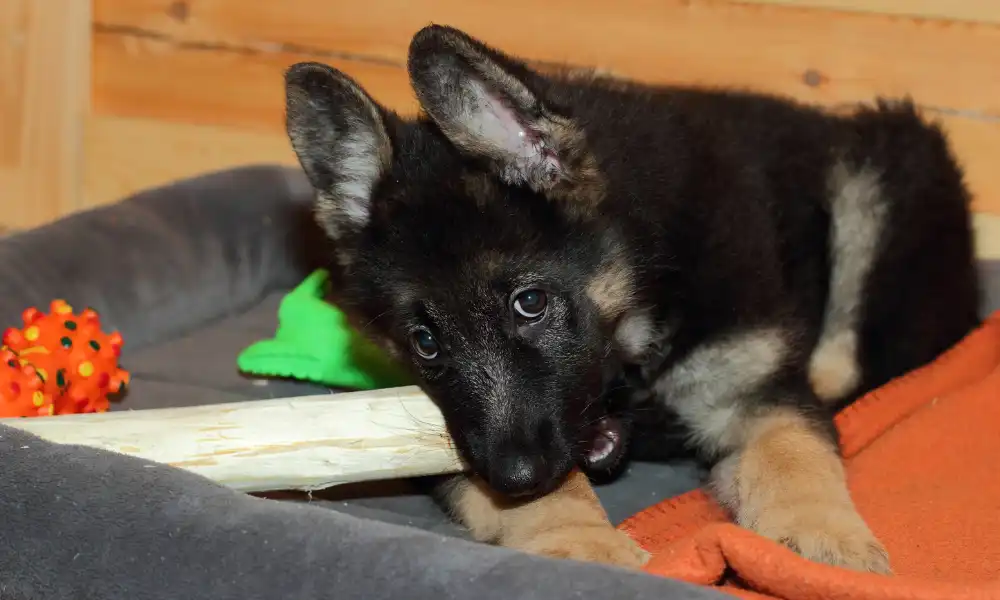


Leave a Reply